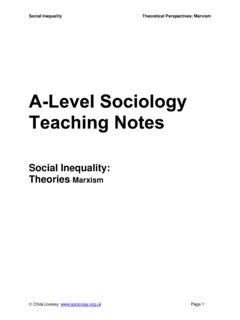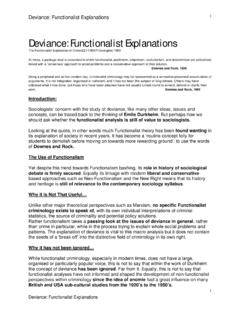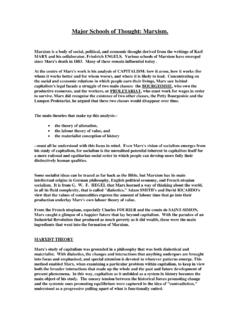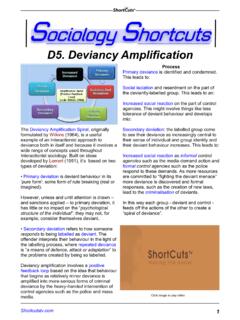Transcription of Produced by D.Keir Coleg Gwent, City of Newport Campus
1 Produced by Coleg gwent , city of Newport Campus A note for A2 students As a module, it is both challenging and rewarding and, if you are studying it for A2, remember the need to look at the relationship between this unit and other units you have studied. At the end of the day, Deviance and Control is a unit that holds great relevance to our society. You will find, on some pages, suggested synoptic links between some of the key themes we have discussed to aid you here just look out for the title - A very important starting point with this module is to recognise that deviance is a continuous variable we tend to have the assumption when thinking of a deviant as someone who has (quite wittingly) broken the law in other words, our assumptions of what a deviant is equate to a term that we all recognise a criminal. However, not all deviants are criminal.
2 Let s have a closer look at the two concepts; Deviance; Imagine you teacher turning up to a lesson wearing a string vest, shorts and cultivating a long straggly beard quite a sight for sore eyes you may imagine! This offers a clear example of a deviant act to deviate means, literally, to stray, or move away from the culturally accepted norms of society. To deviate is also not always bad! A norm = a very common pattern of behaviour in society in this respect, it is an approved way of behaving. Perhaps it might be useful to think back to the Twix advert Break away from the norm ! Deviance, then, is a much more generic (general) category than crime. Indeed, sociology divides deviance into two distinct categories; 1 Informal deviance and; 2 Formal deviance Informal Deviance Informal deviance refers to the fact that an individual (or group of individuals) may be slightly non-conformist to the general trend of society; however, his/her/their behaviour does not constitute an illegal act.
3 In Sociology you will find lots of examples of informal deviants a recent example is David Blaine; Informal deviants are people / groups of people therefore whose behaviour might raise an eyebrow but will not encourage a person to call the police. Informal deviants are people who are simply different for some reason or another. In effect, it is fair to say that we are all informally deviant to some degree or another. In Sociology, there is a fascination with young people because of their informally deviant tendencies particularly when looking at youth subcultures A subculture = a group of people in society whose behaviour (and sometimes style of dress) is significantly different from wider society so much so that they have a unique culture (away of life). However, because they still exist within our society they are called sub cultures. Formal Deviance Formal deviance, quite simply, describes an act committed by a person or group of persons that contravenes (goes against) the established laws of society.
4 A formal deviant is therefore a criminal. Key examples of clear formal deviants are; Harold Shipman, Ted Bundy and Ian Huntley (can you think of any more?) What Haralambos is saying in this above quote therefore, is that what is regarded as formally and informally deviant is never set in stone. The picture is constantly changing. Let s give some examples of this; Where would you put the below deviant acts would they be informally deviant or formally deviant? Domestic violence Smoking Murder Drinking too much Fox hunting Suicide Allowing children to use mobile phones Buying alcohol underage Using Internet chat rooms Graffiti 10 quite different acts clearly, for some we have a gut instinct that they are formally deviant such as domestic violence however, on looking at the issue of domestic violence, this was not always the case; domestic violence was something that was once largely left alone what happened in the family stayed in the family.
5 It is quite possible that some of the acts above that you listed as informally deviant may be formally deviant in the future and vice versa (consider suicide for example an act that was once illegal in Britain now it is informally deviant perhaps it is fair to say just about however) Relative means, therefore, subject to change across time and location. Some societies definition of formally deviant and informally deviant is considerably different from ours for example. It is also the case that we interpret deviant acts in relation to where they happen consider for example one man killing another instantly, we might assume a formally deviant act however, in the context of a war this is acceptable, in the context of a suburb or inner city , this is clear murder. The picture is therefore, never constant in this respect Sociology argues that deviance is a We will examine this point in a little while For A2 students, consider this term social construct it is a term that you have probably come across before for example, the family is a social construct therefore our notion of what a family is, is subject to change across time and location.
6 An important point worth making before we progress is that not all informal deviance is negative informally deviant acts can be positive as well consider, for example, Bono of U2, a Rock and Roll star who perhaps drifts quite considerably from the norm of a Rock and Roll star by getting involved in social issues and charities. Okay, so we made the point above that deviance is socially constructed what is meant by that? Well, in a very simple way, what we regard as informally and formally deviant is determined by society at large if enough people in society over a long period of time feel an act that was informally deviant is formally deviant for example, there might be pressure on the legal system to make such an act formally deviant. Past examples might include stalking, harassing people with text messages and using mobile phones when driving. And vice versa if enough people in society over a long period of time feel that an act which is formally deviant needs to be informally deviant there might be such pressure on the legal system to oblige to such changes for example cannabis has now been down graded (but still illegal in certain contexts).
7 Hagan (1984), a Canadian Criminologist, outlined how society constructs our notion of deviance; He argued that society tends to use three measures of seriousness when judging the degree of deviance of an act. These are; 1) The degree of agreement about the wrongfulness of the act This may range from confusion / apathy to total agreement 2) Severity of the social response elicited by the act; this can range from life imprisonment to polite avoidance, 3) Societies evaluation of the harm elicited by the act; this looks at the degree of victimisation the degree of personal and social harm. If you look back you will find that you probably sub-consciously used these measures to judge the severity of deviance in relation to each of the acts. Let s illustrate this with a few examples ; 1 9/11 an act which undoubtedly scarred America and permanently altered the way we live and see the world in its aftermath; Western society (and it is fair to say, most of the world) was united in the way it saw the extreme wrongfulness of the act; and there was a severe response as a result.
8 2 Cloning an act which, one could argue is likely to be classed as a social diversion or a conflict crime for a while society is divided as to the harm this causes, its wrongfulness and as a result responses are likely to be mixed. We have two types of deviance; Informal deviance (just being different!) And Formal deviance (Breaking the established laws of society being a criminal) All criminals are deviants but not all deviants are criminal. Deviance is a continuous variable it is a bit like trying to mould putty it constantly changes shape and nature. It does this because what is deviant is determined by society Therefore, deviance is a socially constructed term. Thus crime and deviance are relative terms; they are subject to change across time and location. Hand in hand with deviance, however, comes the concept social control For A2 students, the term Social Control will also be a concept you have come across before look at Religion and Marxism how is Religion a form of Social Control, how might the family regarded as a form is Social Control through such a perspective?
9 Remember social control can be positive as well as negative what might Functionalism say about how such institutions control us? Social control exists to prevent negative deviance (that is deviance which can be damaging to others) as most deviance is, it could be argued, negative anyway, we will look simply use the term deviance here There are two types of social control; Informal and Formal For A2 students, this is an excellent opportunity to show your awareness and knowledge of other subject areas in relation to the concept social control Informal Social Control If you had a problem, who would you turn to first? A friend? Family? It is quite likely that you would seek solace in someone you knew who you saw regularly someone who plays a very important part in your life. This is what we mean by informal social control.
10 This form of control is therefore based on the approval or disapproval of those around us whose review of us we regard as important. Hence, the three main groups that fall into this category are; 1) Family, Our basic learning of norms and values (what is regarded as desirable and achievable, often dictating how we should live) are learned in the realm of the family. The family therefore plays a very important role on socialising us and therefore giving us our own identity. It is in this realm that we learn the basic morality of society (note for A2 students which political perspective, however, argues that this is under threat? Why?) and we learn to develop a conscience. The family controls us in a very subtle way unless we do very wrong perhaps where punishment is obvious and pronounced.









